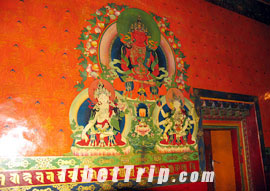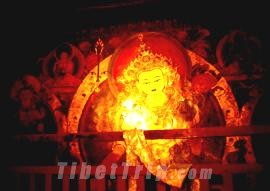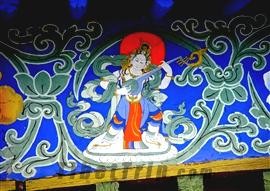
 Religious Murals
Religious Murals
Murals in Tibet focus primarily on religion. Although some early murals devoted to Bon still exist, most of the contemporary murals depict various aspects of Buddhism. The most popular murals are of religious figures, such as Buddhas, Bodhisattvas, Guardians of Buddhist Doctrines, Taras in the sutras, or Buddhist masters. In these paintings, there is always a head deity or human, who is usually surrounded by some other deities or humans. If the central figure is featured alone, his surroundings are extravagantly detailed. Jokhang Temple and Tashilhunpo Monastery have built special courtyards dedicated to this type of mural painting.

In addition to the murals of religious figures, there are also some that focus on religious activities, such as debating sutras, Changmo Dance, the Buddhist cosmologic mandalas , and other Buddhist morality tales. In certain temples, chains of pictures illustrate Tibetan legends or follow the lives of religious figures like Sakyamuni, the founder of Buddhism. One of the most famous legends about the Tibetan ancestors - a monkey and a Raksasi - is told in the murals of Potala Palace and Norbulingka.
 Historical Murals
Historical Murals
Based on the history of Tibet, these murals depict key historical figures and events. There are paintings of ancient Tibetan kings, like Songtsen Gampo (617-650), Trisong Detsen (742-798) and Tri Ralpa Chen (866-896) of Tubo Kingdom, as well as their famous concubines, Princess Wencheng and Princess Jincheng of Tang Dynasty (618-907) and Princess Bhrikuti of Nepal. Their stories are told through the series of pictures in Potala, Jokhang and Norbulingka.
In Potala, there are also chains of pictures about the biography of the 5th Dalai Lama , who had done much to facilitate the friendship of Tibet and the Chinese central government. Two other historical murals of note: in Ruins of Guge Kingdom there are a series of murals about the rise and down of Tubo Kingdom; and an impressive mural in Norbulingka provides a brief illustration of the entire Tibetan history, from the origination of Tibetans to the 14th Dalai Lama's meeting with Chairman Mao.

 Social Murals
Social Murals
Some murals are neither religious nor historical, but rather feature the social life of Tibetans. For example, in Jokhang Temple , there is a group of jubilation murals that shows people singing, dancing, playing musical instruments and engaging in sporting matches. In Potala and Samye Monastery , murals of folk sport activities and acrobatics can also be seen.
In addition, many large palaces or temples in Tibet feature murals that describe their entire architectural design and construction process. These murals can be found in Potala, Jokhang, Samye Temple, Sakya Monastery and other famous buildings in Tibet.
Whether religious, historical or social, all of the murals are elaborate and detailed pieces created by expert artists. In some cases, strict guidelines define the correct way that a key figure should be depicted, so the artist must use his artistic talents to impart subtle differences that will make the mural unique from others that feature the same figure. Colors must be applied properly to make sure the murals do not fade excessively over time.








